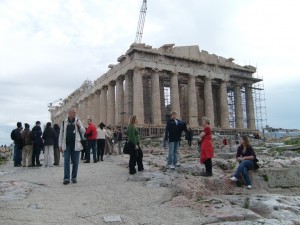Athens’ Major Sites on the Acropolis
Monday, December 27
Whereas we were touring Egypt in a 10-seat van, in Athens, Greece, it’s a Mercedes sedan. Oh bummer. Out at 10:00 am, which is a lot nicer than 6:00 or 7:30. We were greeted by our Greek guide, Matthew.
We all know what “Athens” is, and most “Parthenon”. The fun part here as opposed to looking at pictures is that you can actually walk right up to it. My observation about Athens is that in many ways, it is very similar to San Francisco. 13 hills. Clean streets. Same sort of tall buildings. But it has 5M population vs. maybe 1M for SF.
The Parthenon is on a hill in the middle called the Acropolis (“city on a hill”), with other temples. The columns and general design follow several geometric rules for pleasing design. The Greeks are very proud of the ability of their ancient progenitors to produce excellent buildings.
The Parthenon and the Acropolis have a long history of thousands of years that I can’t go into in detail. It has various underlying building relics that were built on top of from the Byzantine and Ottoman eras. The current structure was restored from what was destroyed by the invasion of the Venetians in the 17th century, and is intended to reflect the basic form from the first few centuries AD. The Parthenon and other main buildings on the Acropolis were built by Pericles in the fifth century BC as a monument to the cultural and political achievements of the inhabitants of Athens.
Back in car – We next visited the Olympic Stadium. Built for the 1896 Olympic games, the structure rests on original Roman foundations dating from the 4th century BC. Each year, the stadium is also the finish line for the revered Athens Marathon. This is exactly what you think of when you envision Greek or Roman stadiums.
We also visited a hilltop to the north of Athens, with a fantastic view of the city. Sort of like Nob Hill in SF.
We took lunch in the Plaka, the old part of the city.  When I first visited Athens in 1970, the city consisted mostly of this area. The rest of the 80% of the city has developed since that time. Now it is a downtown tourist area like a planned shopping area of a major American city, but much funkier, and of course you are in Athens. The lunch experience is as expected, large. But by now we know to eat half or less, and take home our leftovers for dinner.
When I first visited Athens in 1970, the city consisted mostly of this area. The rest of the 80% of the city has developed since that time. Now it is a downtown tourist area like a planned shopping area of a major American city, but much funkier, and of course you are in Athens. The lunch experience is as expected, large. But by now we know to eat half or less, and take home our leftovers for dinner.
That was it, and we came home right afterwards. We spent all Monday evening catching up on our blog, and just taking it easy. We were thinking of taking the bus downtown, but we have not had much down time since Egypt, and we need to unwind. Did a little work and called it a night.

